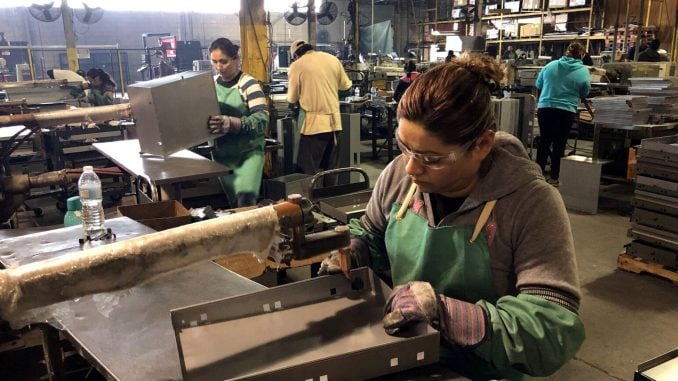
WASHINGTON, D.C. – New applications for U.S. jobless benefits increased more than expected last week, but the number of Americans on unemployment rolls fell to its lowest level since 1973, pointing to diminishing labor market slack.
Other data on Thursday showed an acceleration in mid-Atlantic factory activity this month, with manufacturers saying they were boosting employment and asking for higher prices for their products. The combination of a tightening labor market and firming inflation bolsters expectations the Federal Reserve will raise interest rates next month.
“The U.S. labor market is headed toward becoming the tightest in recent memory,” said Kathryn Asher, an economist at Moody’s Analytics in West Chester, Pennsylvania.
Initial claims for state unemployment benefits rose 11,000 to a seasonally adjusted 222,000 for the week ended May 12, the Labor Department said. Economists polled by Reuters had forecast claims rising to 215,000 in the latest week.
The labor market is viewed as being close to or at full employment, with the jobless rate near a 17-1/2-year low of 3.9 percent and within striking distance of the Fed’s forecast of 3.8 percent by the end of this year. The U.S. central bank raised rates in March and forecast at least two more hikes for this year.
The number of people receiving benefits after an initial week of aid decreased 87,000 to 1.71 million in the week ended May 5, the lowest level since December 1973. Declining continuing claims underscore tightening labor market conditions and support economists’ expectations that wage growth will accelerate in the second half of the year.
The labor market and regional factory data added to strong reports this week on consumer spending and industrial production in suggesting that economic growth was picking up early in the second quarter after slowing at the start of the year.
Growth estimates for the second quarter are around a 3.0 percent annualized rate. The economy grew at a 2.3 percent rate in the January-March period.
A report from the Conference Board on Thursday showed its leading economic index, a gauge of future U.S. economic activity, increased 0.4 percent in April after a similar gain in March. That indicates strong growth should continue into the second half of the year.
The yield on the 30-year U.S. government bond rose to its highest level since July 2015, helping to lift the dollar against a basket of currencies. Stocks on Wall Street were slightly higher.
SOLID JOB GROWTH
The four-week moving average of initial claims, viewed as a better measure of labor market trends as it irons out week-to-week volatility, fell 2,750 to 213,250 last week, the lowest level since December 1969.
The claims data covered the survey period for the nonfarm payrolls portion of May’s employment report.
The four-week average of claims fell 18,250 between the April and May survey periods, suggesting solid job growth. Nonfarm payrolls increased by 164,000 jobs in April after rising by 135,000 in March. Job gains are slowing as employers struggle to find skilled workers.
There were a record 6.6 million unfilled jobs in March, according to government data published last week.
Expectations of strong job growth this month were also bolstered by a separate report on Thursday from the Philadelphia Fed which showed its manufacturing business outlook survey’s current general activity index rose about 11 points to a reading of 34.4 in May.
Manufacturers in the mid-Atlantic region reported hiring more workers this month and increasing hours for their existing workforce. The survey’s employment index rose to a seven-month high. While a measure of prices paid for raw materials by factories in the region fell, it remained at high levels.
The survey’s prices received index rose to its highest reading since February 1989. Nearly 64 percent of the firms expected input price increases over the next six months, and 36 percent anticipated higher prices for their goods.
In response to a special question on prices and wages, manufacturers in the region said they expected changes in prices of their goods to exceed inflation over the next year. They also expected wages and benefits for factory workers to increase 3 percent over the same period.
Though these findings are unchanged from when the same question was asked in February, they fit in with economists’ predictions that inflation will overshot the Fed’s 2 percent target. The U.S. central bank’s preferred inflation measure, the personal consumption expenditures price excluding food and energy, increased 1.9 percent year-on-year in March.
“While the strong growth should continue through the rest of the year, the rising pricing power it is supporting is becoming worrisome,” said Joel Naroff, chief economist at Naroff Economic Advisors in Holland, Pennsylvania.



